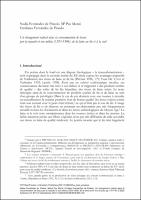Chapter Un changement radical dans la consommation de tissus par la royauté et son milieu (1293-1504): de la laine au lin et à la soie
| dc.contributor.author | Fernandez-de-Pinedo, Nadia | |
| dc.contributor.author | MORAL ZUAZO, MARIA PAZ | |
| dc.contributor.author | Fernández de Pinedo, Emiliano | |
| dc.date.accessioned | 2022-06-01T12:30:08Z | |
| dc.date.available | 2022-06-01T12:30:08Z | |
| dc.date.issued | 2022 | |
| dc.identifier | ONIX_20220601_9788855185653_802 | |
| dc.identifier.uri | https://library.oapen.org/handle/20.500.12657/56618 | |
| dc.description.abstract | Since the reign of Juan II and especially Queen Isabel I of Castile, we have found that silk fabrics had displaced expensive dyed wool cloths from the first place, at least among the privileged groups. At the same time, a very fine linen fabric, the holanda spread in a spectacular way, at least in the case of the House of Isabel I, especially as body linen and household line. In this article, we discuss how these changes could be transmitted downwards through some examples of different social groups - nobility, townspeople, peasants - considering the economic and social limitations that would have been relevant in its diffusion. | |
| dc.language | French | |
| dc.relation.ispartofseries | Datini Studies in Economic History | |
| dc.subject.other | Consumption | |
| dc.subject.other | Textiles | |
| dc.subject.other | Social Status | |
| dc.subject.other | Technology | |
| dc.subject.other | Linen | |
| dc.title | Chapter Un changement radical dans la consommation de tissus par la royauté et son milieu (1293-1504): de la laine au lin et à la soie | |
| dc.type | chapter | |
| oapen.identifier.doi | 10.36253/978-88-5518-565-3.09 | |
| oapen.relation.isPublishedBy | bf65d21a-78e5-4ba2-983a-dbfa90962870 | |
| oapen.relation.isbn | 9788855185653 | |
| oapen.series.number | 2 | |
| oapen.pages | 27 | |
| oapen.place.publication | Florence |

